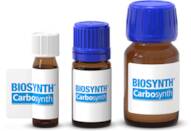Fmoc-Lys(Boc)-Osu
CAS: 132307-50-7
Ref. 3D-FF42926
| 5g | Descontinuado | ||
| 10g | Descontinuado | ||
| 25g | Descontinuado | ||
| 50g | Descontinuado | ||
| 100g | Descontinuado |
Informação sobre produto
- (2,5-Dioxopyrrolidin-1-yl) (2S)-2-(9H-fluoren-9-ylmethoxycarbonylamino)-6-[(2-methylpropan-2-yl)oxycarbonylamino]hexanoate
- L-Lysine, N6-[(1,1-dimethylethoxy)carbonyl]-N2-[(9H-fluoren-9-ylmethoxy)carbonyl]-, 2,5-dioxo-1-pyrrolidinyl ester
- N6-[(1,1-Dimethylethoxy)carbonyl]-N2-[(9H-fluoren-9-ylmethoxy)carbonyl]-L-lysine 2,5-dioxo-1-pyrrolidinyl ester
- Carbamic acid, [5-[[(1,1-dimethylethoxy)carbonyl]amino]-1-[[(2,5-dioxo-1-pyrrolidinyl)oxy]carbonyl]pentyl]-, 9H-fluoren-9-ylmethyl ester, (S)-
- Carbamic acid, [(1S)-5-[[(1,1-dimethylethoxy)carbonyl]amino]-1-[[(2,5-dioxo-1-pyrrolidinyl)oxy]carbonyl]pentyl]-, 9H-fluoren-9-ylmethyl ester
Fmoc-Lys(Boc)-Osu is a compound that is used to synthesize a variety of peptides with a lysine residue at the carboxy terminus. The phenyl group in this molecule acts as an angiotensin receptor antagonist and oxytocin receptor agonist. It also has the ability to inhibit cyclic AMP formation, which is important for cardiovascular function. The Fmoc-Lys(Boc)-Osu molecule can be used as a diagnostic tool to measure cerebral blood flow, as well as to study the effects of trifluoromethyl groups on various reactions.





